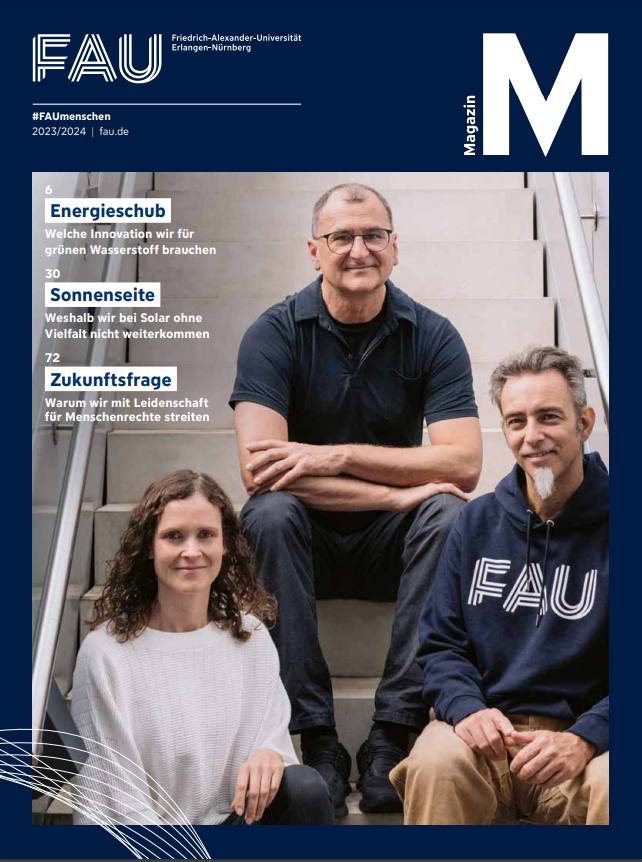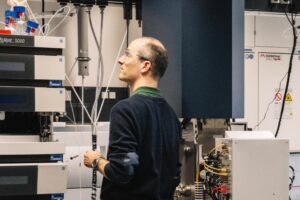The designers of atomic structures
Julien Bachmann and Andreas Hirsch in search of new materials
It started with amazement: “In chemistry lessons at school, we were allowed to do experiments involving liquids changing color. It found it fascinating that we can change materials like that,” explains Julien Bachmann, Chair of Chemistry of Thin Film Materials at FAU and member of the board of the FAU Profile Center New Materials and Processes. Later, he became interested in creating new structures, “like an engineer, but at a much smaller scale.” Work on his undergraduate thesis at the University of Lausanne introduced Bachmann to coordination chemistry. This field of chemistry involves research into compounds consisting of a central metal ion and one or several organic ligands. Such complexes are often used as catalysts.
If you want to go abroad, go to MIT!
He didn’t think much about his career at the beginning. The encouragement he needed was given by a laboratory manager from the cosmetic industry, where Bachmann worked during the semester break: “If you want to go abroad, go to MIT!” Bachmann followed his advice. During his doctoral thesis, he conducted research into new fundamental principles of catalysis in water electrolysis. “I was able to demonstrate that complexes can be created in such a way that not only the metal ion but also the ligand are involved in the exchange of electrons. That was not a major area of research at that time.”
As he hoped to gain a more in-depth understanding of electron transfer on surfaces after completing his doctoral degree, Bachmann joined the Max-Planck Institute of Microstructure Physics in Halle. After working as an assistant professor at the University of Hamburg, he was appointed to a professorship in Erlangen in 2012.
At the current time, Julien Bachmann is developing methods that can be used to accurately define and systematically vary the geometry of nanostructures. “My aim is to optimize the efficiency of solar cells, electrolyzers or artificial photosynthesis on the basis of readily available, reasonably priced and non-toxic materials,” he explains. “Coating processes such as atomic layer deposition have an important role to play.” In 2019, he joined with partners to found the company “Atlant 3D nanosystems”. The company develops innovative 3D printers that are capable of producing sensors with atomic accuracy.
It turned out to be Erlangen after all
Andreas Hirsch, Chair of Organic Chemistry II at FAU, was also fascinated by the possibilities offered by electronic materials from an early stage. “I wrote my undergraduate and doctoral theses at the University of Tübingen with Michael Hanack. He was one of the first chemists in Germany to focus on molecules that conduct electricity,” Hirsch explains. Hanack’s working group already collaborated with physicists and materials scientists before this became common practice in organic chemistry.
After spending time as a postdoctoral researcher in Santa Barbara, Hirsch returned to Tübingen to research the chemistry of the “soccer-ball” shaped molecule, C60, and other fullerenes. “It was a very successful period during which a number of pioneering discoveries were made,” he remembers. In 1995, he was appointed as a professor at FAU, turning down several lucrative offers from abroad. “At that time, Erlangen did not have the outstanding reputation it does today, but FAU offered good working conditions and the city of Erlangen offered a high quality of life.” Companies such as Siemens, Adidas and Schaeffler stood for a cosmopolitan outlook and an international approach. According to Hirsch, “Bavaria offers excellent funding for research, and the initial budget for Chemistry chairs is very good compared to other states in Germany.”
For 12 years now, Andreas Hirsch has headed a collaborative research center with 25 working groups that focus on the chemical and physical properties of synthetic carbon allotropes, carbon nanotubes and graphenes. “Thanks to the funding from the DFG, we are the leading carbon research center worldwide,” Hirsch states.
Hirsch is a passionate chemist, but he also has several interests outside of science. “I have been interested from an early age in music, and in cultural and historical topics,” he explains. Since 2022, Hirsch has been involved in the Executive Board of the University as Vice President People, and is making an effort to ensure that FAU positions itself as an innovative incubator of talent.
by Mathias Orgeldinger
Profile Center New Materials and Processes (FAU NMP)
The Profile Center encourages and strengthens innovative interdisciplinary research in the area of new materials and processes at FAU. It continues the successful work of the Cluster of Excellence Engineering of Advanced Materials (EAM), which enabled the University to gain a leading position in this field of research in Germany and abroad. One of the aims of FAU NMP is to use new chemical synthesis processes and the miniaturization of chemical laboratories to create artificial materials with a perfect atomic structure that are more powerful and at the same time more sustainable than has been the case to date.
This article is part of the FAU Magazin

A university thrives because of the people who research, study, teach and work there. A university is supported by people who are connected to it as alumni, friends and sponsors and who are committed to promoting its interests all over the world.
They all contribute their unique talents, skills and perspectives. It is this diversity that makes our FAU a place of innovation, a place where many talented individuals tackle the major challenges of our times together, and a place where they keep finding answers.
Read more articles online Download: FAU Magazin (PDF)


